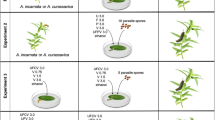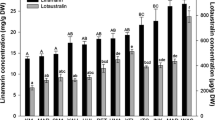Abstract
Root, stem, leaf, and latex samples ofAsclepias eriocarpa collected from three plots in one population at 12 monthly intervals were assayed for total cardenolide content by spectroassay and for individual cardenolides by thin-layer chromatography. From May to September mean milligram equivalents of digitoxin per gram of dried plant were: latices, 56.8 ≫ stems, 6.12 > leaves, 4.0 > roots, 2.5. With the exception of the roots, significant changes in gross cardenolide content occurred for each sample type with time of collection during the growing season, whereas variation within this population was found to be small. Labriformin, a nitrogen-containing cardenolide of low polarity, predominated in the latices. Leaf samples contained labriformin, labriformidin, desglucosyrioside, and other unidentified cardenolides. In addition to most of the same cardenolides as the leaves, the stems also contained uzarigenin. The roots contained desglucosyrioside and several polar cardenolides. The results are compared with those for other cardenolide-containing plants, and discussed in relation to anti-herbivore defense based on plant cardenolide content. Arguments are advanced for a central role of the latex in cardenolide storage and deployment which maximizes the defensive qualities of the cardenolides while preventing toxicity to the plant.
Similar content being viewed by others
References
Barthakur, P. 1971. Programs 1324 EB/ST4 and 1326 EB/ST4, pages 6–8, 12–14, 700 Series Program Library, Vol. 9, Wang Laboratories, Inc., Tewkesbery, Massachusetts.
Benson, J.M., Seiber, J.N., Keeler, R.F., andJohnson, A.E. 1978. Studies on the toxic principle ofAsclepias eriocarpa andAsclepias labriformis, pp. 273–284,in R.F. Keeler, K.R. van Kampen, and L.F. James (eds.). Effects of Poisonous Plants on Livestock. Academic Press, New York.
Benson, J.M., Seiber, J.N., Bagley, C.V., Keeler, R.F., Johnson, A.E., andYoung, S. 1979. Effects on sheep of the milkweedsAsclepias eriocarpa andA. labriformis and of cardiac glycoside-containing derivative material.Toxicon 17:155–165.
Brower, L.P. 1969. Ecological chemistry.Sci. Am. 220:22–29.
Brower, L.P. 1970. Plant poisons in a terrestrial food chain and implications for mimicry theory, pp. 69–82,in K.L. Chambers (ed.). Proceedings of the 29th Annual Biological Colloquium, 1968, Biochemical Coevolution. Oregon State University Press, Corvallis.
Brower, L.P., andGlazier, S.C. 1975. Localization of heart poisons in the monarch butterfly.Science 188:19–25.
Brower, L.P., andHuberth, J.C. 1977. Strategy for Survival: Behavioral ecology of the monarch butterfly (motion picture film). Copyright 1977. (30 minutes, 16 mm, color cond.) Released by Harper and Row Media, September 1977, 2350 Virginia Ave., Hagerstown, Maryland 21740.
Brower, L.P., McEvoy, P.B., Williamson, K.L., andFlannery, M.A. 1972. Variation in cardiac glycoside content of monarch butterflies from natural populations in eastern North America.Science 177:426–429.
Brower, L.P., Edmunds, M., andMoffitt, C.M. 1975. Cardenolide content and palatability of a population ofDanaus chrysippus butterflies from West Africa.J. Entomol. (A)49:183–196.
Brower, L.P.,Seiber, J.N.,Nelson, C.J.,Lynch, S.P., andTuskes, P.M. 1982. Plant determined variation in the cardenolide content, thin layer chromatography profiles, and emetic potency of monarch butterflies,Danaus plexippus reared on the milkweed,Asclepias eriocarpa in California.J. Chem. Ecol. In press.
Brown, H.D., Neucere, N.J., Altschul, A.M., andEvans, W.J. 1965. Activity patterns of purified ATPase fromArachis hypogaea.Life Sci. 4:1439–1447.
Brown, P., von Euw, J., Reichstein, T., Stöckel, K., andWatson, T.R. 1979. Cardenolides ofAsclepias syriaca L., probable structure of syrioside and syriobioside.Helv. Chim. Acta 62:412–441.
Brüschweiler, F., Stocklin, W., Stöckel, K., andReichstein, T. 1969a. Die Glykoside vonCalotropis procera R. Br.Helv. Chim. Acta 52:2086–2106.
Brüschweiler, F., Stöckel, K., andReichstein, T. 1969b.Calotropis glycoside, presumed partial structure,Helv. Chim. Acta 52:2276–2303.
Cates, R.G. andRhoades, D.F. 1977. Patterns in the production of antiherbivore chemical defenses in plant communities.Biochem. Syst. Ecol. 5:185–193.
Cheung, H.T., Watson, T.R., Seiber, J.N., andNelson, C.J. 1980. 7β,8β-Epoxy-cardenolide glycosides ofAsclepias eriocarpa.J. Chem. Soc. Perkin I. 1980:2169–2173.
Daloze, D., andPasteels, J.M. 1979. Production of cardiac glycosides by chrysomelid beetles and larvae.J. Chem. Ecol. 5:63–77.
Duffey, S.S., Blum, M.S., Isman, M.B., andScudder, G.G.E. 1978. Cardiac glycosides: A physical system for their sequestration by the milkweed bug.J. Insect Physiol. 24:639–645.
Esau, K. 1965. Plant Anatomy, 2nd ed. Wiley & Sons, New York.
Evans, F.J. 1977. A new phorbol triester from the latices ofEuphorbia frankiana andE. coerulescens.Phytochemistry 16:395–396.
Evans, F.J., andCowley, P.S. 1972. Cardenolides and spirostanols inDigitalis purpurea at various stages of development.Phytochemistry 11:2971–2975.
Evans, F.J., andSchmidt, R.J. 1976. Two new toxins from the latex ofEuphorbia poisonii.Phytochemistry 15:333–335.
Euw, J. von, Fishelson, L., Parsons, J.A., Reichstein, T., andRothschild, M. 1967. Cardenolides (heart poisons) in a grasshopper feeding on milkweeds.Nature 214:35–39.
Fairbairn, J.W., Hakim, F., andEl Kheir, Y. 1974. Alkaloidal storage, metabolism and translocation in the vesicles ofPapaver somniferum latex.Phytochemistry 13:1133–1139.
Feeny, P. 1970. Seasonal changes in oak leaf tannins and nutrients as a cause of spring feeding by winter moth caterpillars.Ecology 51:565–581.
Feeny, P. 1975. Biochemical coevolution between plants and their insect herbivores, pp. 3–19,in L.E. Gilbert and P.H. Raven (eds.). Coevolution of Animals and Plants. University of Texas Press, Austin.
Haupt, I. 1976. Separation of the sites of synthesis and accumulation of 3,4-dihydroxyphenyl-alanine inEuphorbia lathyris L.Nova Acta Leopold. Suppl. 7:129–132.
Isman, M.B., Duffey, S.S., andScudder, G.G.E. 1977a. Cardenolide content of some leaf-and stem-feeding insects on temperate North American milkweeds (Asclepias spp.).Can J. Zool. 55:1024–1028.
Isman, M.B., Duffey, S.S., andScudder, G.G.E. 1977b. Variation in cardenolide content of the Lygaeid Bugs,Oncopeltus fasciatus andLygaeus kalmii kalmii and of their milkweed hosts (Asclepias spp.) in central California.J. Chem. Ecol. 3:613–624.
Jones, D.A. 1972. Cyanogenic glycosides and their function, pp. 103–124,in J.B. Harborne (ed.). Phytochemical Ecology. Academic Press, New York.
Jungreis, A.M., andVaughan, G.L. 1977. Insensitivity of lepidopteran tissues to ouabain: Absence of ouabain binding and Na+-K+ ATPases in larval and adult midgut.J. Insect Physiol. 23:503–509.
Karawya, M.S., Balbaa, S.I., andKhayyal, S.E. 1973. Estimation of Cardenolides inNerium oleander.Planta Med. 23:70–73.
Kingsbury, J.M. 1964. Poisonous Plants of the United States and Canada. Prentice-Hall, New Jersey.
Kojima, M., Poulton, J.E., Thayer, S.S., andConn, E.E. 1979. Tissue distributions of dhurrin and of enzymes involved in its metabolism in leaves ofSorghum bicolor.Plant Physiol. 63:1022–1028.
Kupchan, S.M., Mokotoff, M., Sandhu, R.S., andHokin, L.E. 1967. The chemistry and biological activity of derivatives of strophanthidin.J. Med. Chem. 10:1025–1033.
Kupchan, S.M., Uchida, I., Shimada, K., Yu Fri, B., Stevens, D.M., Sneden, A.T., Miller, R.W., andBryan, R.F. 1977. Elaeodendroside A: a novel cytotoxic cardiac glycoside fromElaeodendron glaucum.J. Chem. Soc. Chem. Commun. 1977:255–256.
Levin, D.A. 1971. Plant phenolics: An ecological perspective.Am. Nat. 105:157–181.
Levin, D.A. 1976. The chemical defenses of plants to pathogens and herbivores.Annu. Rev. Ecol. Syst. 7:121–159.
Loffelhardt, W., Kopp, B., andKubelka, W. 1979. Intracellular distribution of cardiac glycosides in leaves ofConvallaria majalis.Phytochemistry 18:1289–1291.
MacRobbie, E.A.C. 1962. Ionic relatons ofNitella translucens.J. Gen. Physiol. 45:861–878.
Masler, L., Bauer, Ŝ., Bauerová, O. andŜikl, D. 1962. Cardiac glycosides ofAsclepias syriaca L. I. Isolation of the cardio-active steroids.Collect. Czech. Chem. Commun. 27:872–881.
Matile, P. 1976. Localization of alkaloids and mechanism of their accumulation in vacuoles ofChelidonium majus laticifers.Nova Acta Leopold. Suppl. 7:139–156.
Matile, P., Jans, B., andRickenbacher, R. 1970. Vacuoles ofChelidonium latex: Lysosomal property and accumulation of alkaloids.Biochem. Physiol. Pflanzen 161:447–458.
McKey, D. 1974. Adaptive patterns in alkaloid physiology.Am. Nat. 108:305–320.
McKey, D. 1979. The distribution of secondary compounds within plants, pp. 55–133,in G.A. Rosenthal and D.H. Janzen (eds.). Herbivores. Academic Press, New York.
Mülles, E. 1976. Principles in transport and accumulation of secondary products.Nova Acta Leopold. Suppl. 7:123–128.
Neumann, D. 1976. Interrelationship between the morphology of alkaloid storage cells and the possible mechanism of alkaloid storage.Nova Acta Leopold. Suppl. 7:77–81.
Nie, N.H., Hull, C.H., Jenkins, J.G., Steinbrenner, K., andBent, D.U. 1977. Statistical Package for the Social Sciences, SPSS 6000, 2nd ed., Version 7. McGraw-Hill, New York.
Pasteels, J.M., Daloze, D., van Dorsser, W., andRoba, J. 1979. Cardiac glycosides in the defensive secretion ofChrysolina herbacea (Coleoptera, Chrysomelidae). Identification, biological role and pharmacological activity.Comp. Biochem. Physiol. 63C:117–121.
Price, P.W., andWillson, M.F. 1979. Abundance of herbivores on six milkweed species in Illinois.Am. Midl. Nat. 101:76–86.
Rafaeli-Bernstein, A., andMordue, W. 1978. The transport of the cardiac glycoside ouabain by the Malpighian tubules ofZonocerus variegatus.Physiol. Entomol. 3:59–63.
Rhoades, D.F., andCates, R.G. 1976. A general theory of plant antiherbivore chemistry, pp. 168–213,in J.W. Wallace and R.L. Mansell (eds.). Recent Advances in Phytochemistry, Biochemical Interactions between Plants and Insects, Vol. 10. Plenum Press, New York.
Roeske, C.N., Seiber, J.N., Brower, L.P., andMoffitt, C.M. 1976. Milkweed cardenolides and their comparative processing by monarch butterflies (Danaus plexippus L.), pp. 93–167,in J.W. Wallace and R.L. Mansell (eds.). Recent Advances in Phytochemistry, Biochemical Interactions between Plants and Insects, Vol. 10. Plenum Press, New York.
Rothschild, M., andReichstein, T. 1976. Some problems associated with the storage of cardiac glycosides by insects.Nova Acta Leopold. Suppl. 7:507–550.
Rowson, J.M. 1952. Studies in the genusDigitalis, Part I. The colorimetric estimation of digitoxin and preparations ofDigitalis purpurea.J. Pharm. Pharmacol. 4:814–830.
Scriber, J.M. 1978. The effects of larval feeding specialization and plant growth form on the consumption and utilization of plant biomass and nitrogen: An ecological consideration.Entomol. Exp. Appl. 24:494–510.
Seiber, J.N.,Nelson, J.C., andLee, S.M. 1981. Cardenolides in the latex and leaves of sevenAsclepias species andCalotropis procera. Submitted for publication.
Seiber, J.N., Roeske, C.N., andBenson, J.M. 1978. Three new cardenolides from the milkweedsAsclepias eriocarpa andA. labriformis.Phytochem. 17:967–970.
Seiber, J.N., Tuskes, P.M., Brower, L.P., andNelson, C.J. 1980. Pharmacodynamics of some individual milkweed cardenolides fed to larvae of the monarch butterfly.J. Chem. Ecol. 6:321–339.
Seigler, D.S. 1977. Primary roles for secondary compounds.Biochem. Syst. Ecol. 5:195–199.
Swain, T. 1976. Secondary compounds: Primary products.Nova Acta Leopold. Suppl. 7:411–421.
Swain, T. 1977. Secondary compounds as protective agents.Annu. Rev. Plant Physiol. 28:479–501.
Thomashow, P. 1975. The paradox of the cryptic chrysalid. Senior honors thesis, Amherst College, Amherst, Massachusetts.
Vaughan, F.A. 1979. Effect of gross cardiac glycosides of seeds of common milkweed,Asclepias syriaca, on cardiac glycoside uptake by the milkweed bugOncopeltus fasciatus.J. Chem. Ecol. 5:89–100.
Vaughan, G.L., andJungreis, A.M. 1977. Insensitivity of Lepidopteran tissues to ouabain: Physiological mechanisms for protection from cardiac glycosides.J. Insect Physiol. 23:585–589.
Author information
Authors and Affiliations
Additional information
Research supported by National Science Foundation Grants DEB 75-14266 and DEB 78-15419 (U.C. Davis) and DEB 75-14265, DEB 78-10658, and DEB 80-40388 (U.F.)
Rights and permissions
About this article
Cite this article
Nelson, C.J., Seiber, J.N. & Brower, L.P. Seasonal and intraplant variation of cardenolide content in the California milkweed,Asclepias eriocarpa, and implications for plant defense. J Chem Ecol 7, 981–1010 (1981). https://doi.org/10.1007/BF00987622
Received:
Revised:
Issue Date:
DOI: https://doi.org/10.1007/BF00987622




